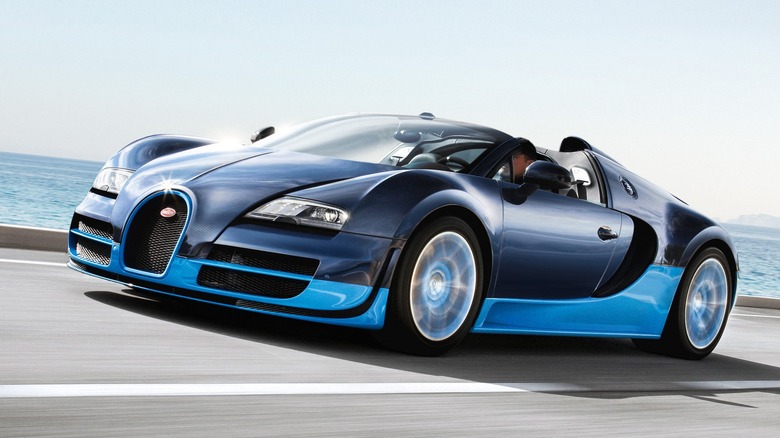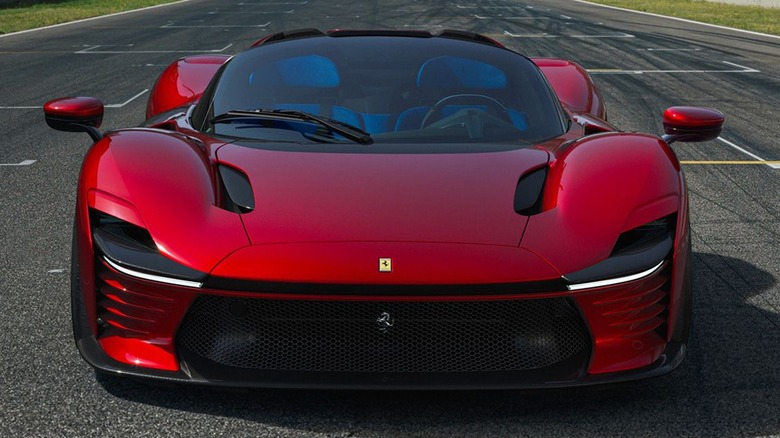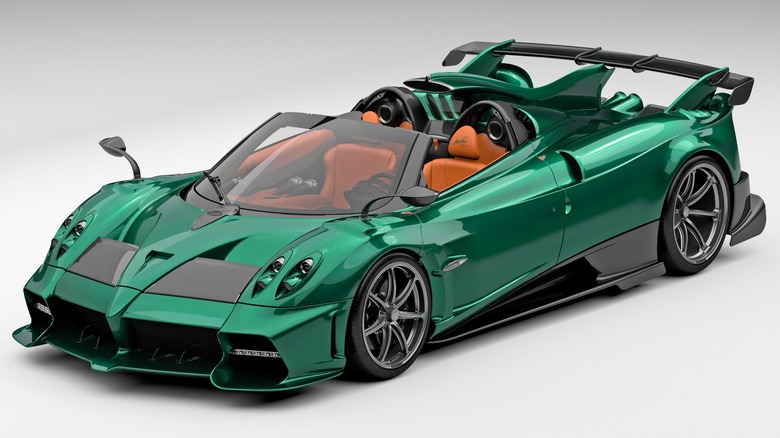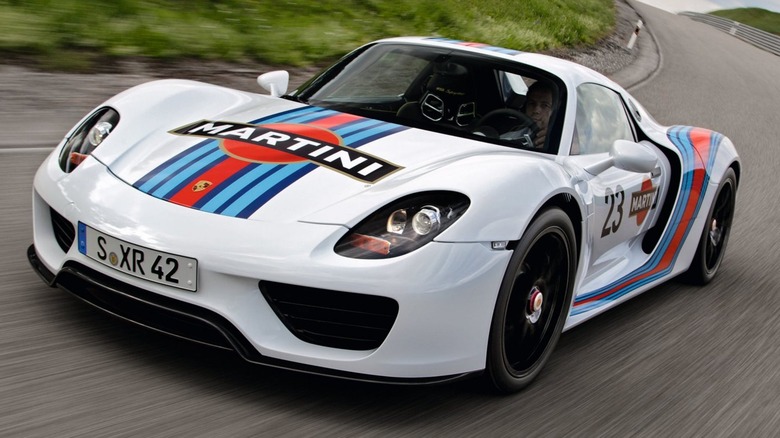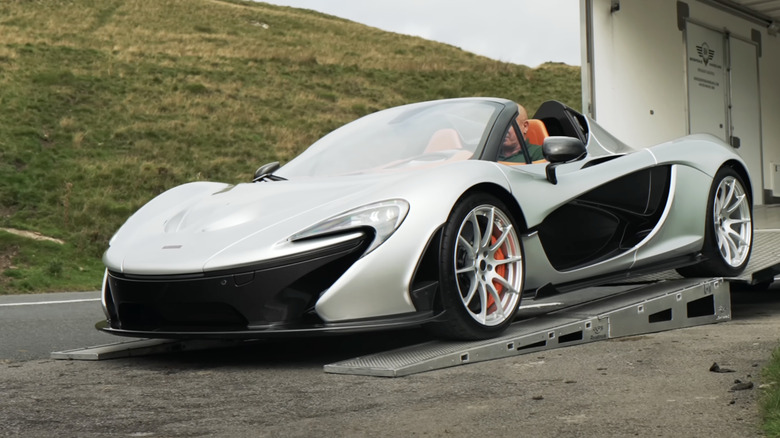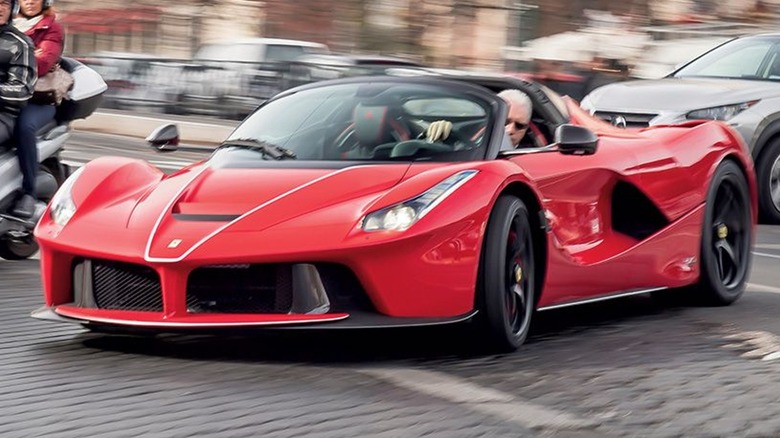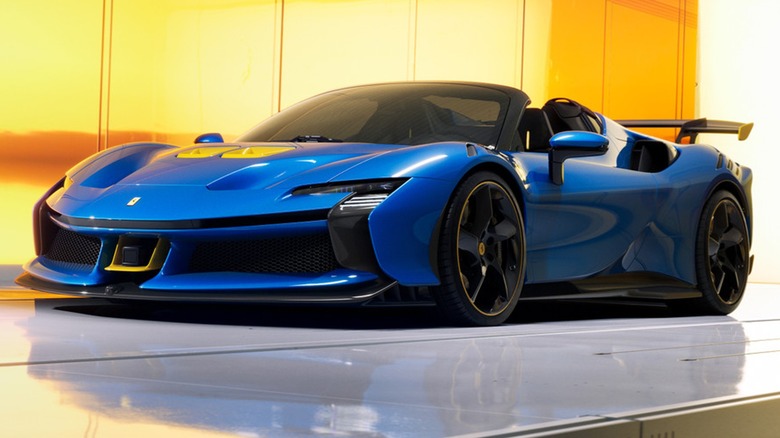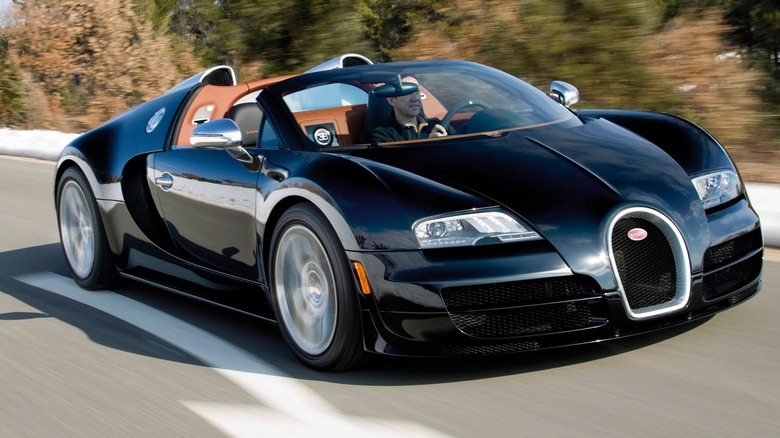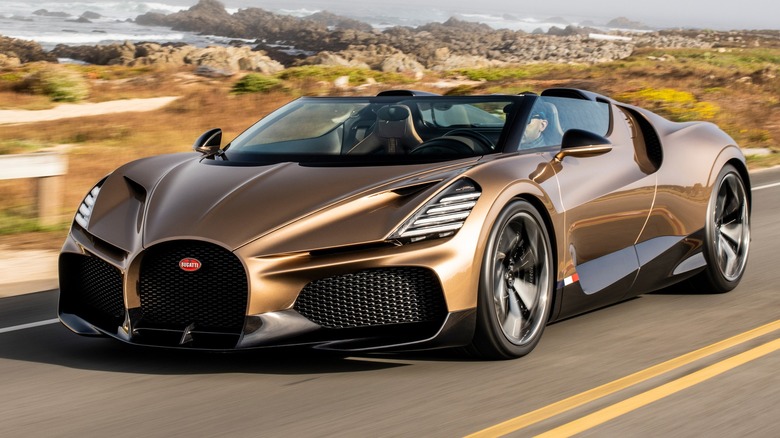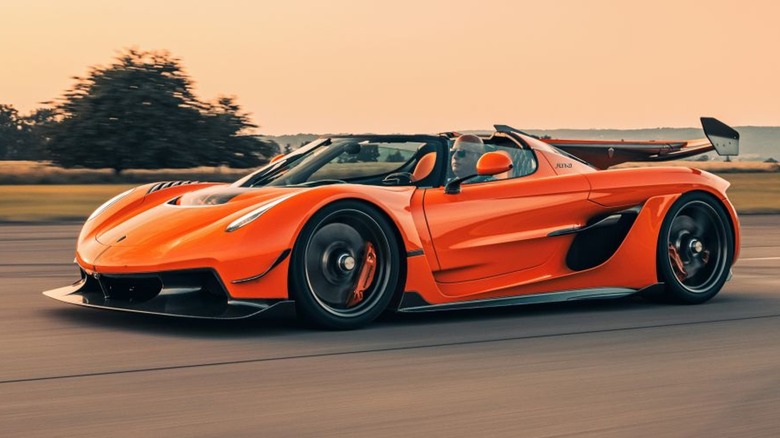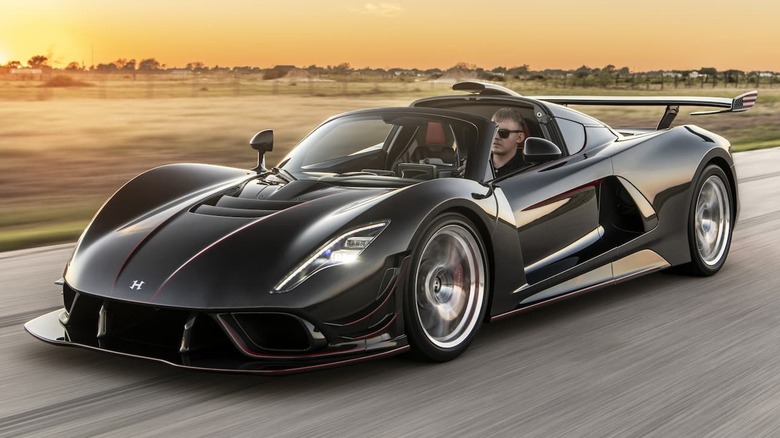10 Of The Most Powerful Roadsters Ever Made, Ranked
Roadsters are the open-air chariots of the driving world. Unlike their coupe counterparts, roadsters trade the solid roof for the exhilarating freedom of the open sky. They promise a heightened driving experience, transforming every journey into a multi-sensory adventure. Besides the undeniable thrill of driving with the top down, some roadsters are also lighter than their coupe counterparts and thus offer a more responsive and agile driving experience. While some coupes provide superior performance, they can be isolating, separating the driver from the raw emotions of the road.
Europe is home to most of these iconic automotive titans, with brands like Bugatti, Ferrari, Koenigsegg, McLaren, and Pagani consistently producing breathtaking roadsters that define the limits of speed and power. However, the American spirit of innovation isn't left behind, with brands like Hennessey challenging European dominance with its blend of open-air exhilaration and raw power.
Below, we explore the roadsters that redefine power, handling, and the essence of open-air driving. We'll look into their legacy, design philosophies, and powertrains, ranking them based on their horsepower.
10. Ferrari Daytona SP3 – 829 hp
The Ferrari Daytona SP3 is a beautiful supercar and the second addition to Ferrari's Icona Series. The first models of the Icona Series were the stunning retro-style Monza SP1 and SP2, which evoked the seductive designs of '50s barchettas. The Daytona SP3 is a limited-edition Targa that evokes Ferrari's racing pedigree from the 1960s. It uses a mid-engine 6.5-liter naturally aspirated V12 engine, producing 829 hp at 9,250 rpm and 514 lb-ft of torque at 7,250 rpm. The engine pairs with a seven-speed dual-clutch automatic transmission, sending power to the rear wheels. Despite the Daytona SP3 being the least potent roadster on the list, it boasts an impressive 0 to 62 mph dash of 2.85 seconds and a respectable 211 mph top speed.
The Daytona SP3 celebrates Ferrari's history — referencing its legendary 1967 24 Hours of Daytona victory — while offering enthusiasts a modern iconic vehicle with innovative materials and technologies. The Daytona SP3's interior takes a lot of inspiration from classics like the 350 Can-Am, 312 P, and the 330 P3/4. This translates into a minimalist interior with a functional dashboard and fixed modern single-piece seats integrated into the chassis. Ferrari also adds unique touches on the Daytona SP3, including fender-mounted rear-view mirrors for better visibility and airflow. In addition, the Daytona SP3 also gets a removable carbon fiber top and butterfly doors with an integrated air box.
9. Pagani Imola Roadster – 838 hp
Pagani's Imola Roadster is a high-performance vehicle that helps showcase the company's sophisticated design and prowess. The Imola Roadster is limited to only eight road-going specimens, using a twin-turbocharged 6.0-liter Pagani V12 engine producing 838 hp at 5,600 rpm and 811 lb-ft of torque. The V12 mates with a seven-speed transversal sequential AMT, sending power to the rear wheels. This enables the Imola Roadster to achieve a limited top speed of 217.5 mph.
Despite sharing its name with the Imola coupe, the Imola Roadster borrows the design, aerodynamic principles, and technology of the Huayra Roadster BC and the Huayra R. Thanks to this approach, the Imola Roadster uses advanced composite materials, including a firmer Carbo-Triax HP62 and Carbo-Titanium HP62-G2 chassis which promises a race car driving experience. The Imola Roadster's lightweight chassis contributes to the vehicle's overall weight of just 2,776.7 pounds. This construction, together with the Imola Roadster's aerodynamic efficiency, enables the Imola Roadster to boast 1,323 pounds of downforce at 174 mph.
Pagani merges the Imola Roadster's performance with its breathtaking interior, featuring unique materials like finely embossed leather, carbo-wood, and carbon fiber monocoque seats with a four-point racing-style harness. In addition to these components, the Imola Roadster has a seven-channel audio system with bass reflex on the door panels, offering a crystal clear and immersive auditory experience.
8. Porsche 918 Spyder – 887 hp
Porsche first introduced the 918 Spyder at the Geneva Motor Show in 2010. At the time, the 918 was just a prototype showcasing Porsche's prowess and the brand's next super sports car. After three years of development, Porsche later introduced the first 918 in 2013 at the International Motor Show. The Porsche 918 Spyder was a plug-in hybrid super sports car, boasting a mid-mounted 4.6-liter V8 and two electric motors, producing a combined 887 hp. Porsche enhanced the 918's dynamic performance with a unique all-wheel-drive system that combined the ICE with the electric motors.
One motor powered the front wheels, while the engine and the other motor powered the rear wheels. This enabled the 918 to have controllable front-wheel drive, allowing drivers to maneuver corners with speed comfortably. While the 918 was less powerful than the 903 hp McLaren P1, the 918 Spyder was quicker, sprinting from 0 to 62 mph in just 2.6 seconds. In addition, the 918 demonstrated its capabilities with a Nürburgring lap record of 6:57 minutes. This made it the first road-approved vehicle to break the seven-minute Nürburgring Nordschleife mark.
7. Lanzante McLaren P1 Spider – 903 hp
The McLaren P1 supercar was unveiled in 2012 as one of the first hybrids of its kind in the world, thanks to McLaren's F1 engineering. When McLaren introduced the P1, it was among the best driver's cars on the track and road. McLaren used its five decades of racing success to make the P1 a lightweight and aerodynamic supercar, resulting in unimaginable downforce — 1,323 pounds at 161 mph — more in line with a GT3 racing car. McLaren fitted the P1 with a twin-turbocharged 3.8-liter V8 engine and a single electric motor, producing a combined 903 hp.
The use of hybrid technology gave P1 instant torque, allowing it to dash from 0 to 62 mph in 2.8 seconds and reach an electronically limited 217 mph top speed. In addition, the P1 had astonishing technology, including adjustable suspension and active aerodynamics. This helped optimize airflow to maximize its downforce. While all this made the P1 an impressive supercar, McLaren only made it as a coupe, making it the only vehicle in the "holy trinity" that didn't have a roadster.
Fortunately, Lanzante created a Spider, offering a few P1 buyers an open-air experience. Lanzante's McLaren P1 Spider retains most of the coupe's internals, including the hybrid powertrain. However, it features a redesigned rear deck, creating room for a retractable roof system. Lanzante also customized the interior with SuperFabric, a leather material more resistant to UV rays and weather. In addition, the P1 Spider has an optional 4.0-liter Cosworth engine, helping bump its power.
6. Ferrari LaFerrari Aperta – 947 hp
Ferrari introduced the LaFerrari in 2013. One of the company's most ambitious projects, the LaFerrari was a hybrid super sports car, offering the most extreme performance ever in a Ferrari production car. This super sports car competed with rivals like the Porsche 918 Spyder and the McLaren P1. Unlike its competitors, the LaFerrari had a mighty 6.3-liter V12 engine and an electric motor, producing 947 hp and 664 lb-ft of torque. Despite being more powerful than its rivals, the LaFerrari had a slower 0 to 62 mph run of 2.9 seconds.
Introduced in 2016, the LaFerrari Aperta offered customers an open-air experience thanks to its removable top. Ferrari reinforced the Aperta's lower sections, which allowed it to deliver the same torsional rigidity as the coupe. While the roadster looked like its coupe sibling, Ferrari made multiple changes to ensure the occupants had a great open-air experience. These included an angled wind stop, which channeled air through the vehicle's interior structure, and a revised radiator layout to keep the hot air from reaching the cockpit.
In addition to these tweaks, the LaFerrari Aperta offered unprecedented performance, like the coupe. These vehicles shared Ferrari's algorithms like HY-KERS, which kept the engine revving up when cornering, allowing quicker accelerator pedal response times when exiting the corners.
5. Ferrari SF90 XX Spider – 1,016 hp
The Ferrari SF90 XX Spider is the most extreme version of the SF90 Spider. Unlike the base SF90 Spider, the SF90 XX Spider pushes performance, aerodynamics, and vehicle dynamics to the limit. It uses a twin-turbocharged 4.0-liter V8 and three electric motors, pushing the output to 1,016 hp. Ferrari achieves this power output by machining the combustion chamber and optimizing the exhaust system. The result is a 2.3-second 0 to 62 mph sprint and a 199-mph top speed.
Besides its performance increase, the SF90 XX Spider adds more tweaks, including two new front vertical wing profiles, a rear lightbar, a rear long-tail profile, and a massive fixed rear wing. These revised aero elements provide more downforce, enabling the SF90 XX Spider to boast 1,389 pounds of downforce at 155 mph. The SF90 XX Spider also carries over the retractable hard top and active rear spoiler of the SF90 Spider. This spoiler works hand in hand with the fixed rear wing, switching between high downforce and low drag positions.
Qualifying mode is a new feature in the SF90 XX lineup, providing an additional power boost when exiting corners. In addition to its complex engineering, the SF90 XX Stradale and SF90 XX Spider get a revised interior with new carbon fiber monocoque bucket seats, a matte-finished carbon fiber center console, and stripped-out carpeting. While they both inherit the track-based XX moniker, the SF90 XX Stradale and SF90 XX Spider are still road cars but with the visual appeal of a track car. Unfortunately, this limited-edition Ferrari will only be available with 799 SF90 XX Stradales and 599 SF90 XX Spiders.
4. Bugatti Veyron 16.4 Grand Sport Vitesse – 1,200 hp
Bugatti introduced the Veyron 16.4 Grand Sport Vitesse in 2012, a roadster version of the already successful Bugatti Veyron 16.4 Super Sport. The Veyron 16.4 Grand Sport Vitesse used the incredible quad-turbocharged 8.0-liter W16 engine, producing 1,200 hp and 1,106 lb-ft of torque, making it one of the most powerful roadsters. This powertrain is paired with a seven-speed dual-clutch automatic, sending power to all four wheels. These incredible figures enabled the Grand Sport Vitesse to scamper from 0 to 62 mph in 2.6 seconds and reach a 255-mph top speed.
At the time, this was the fastest production roadster ever, with race car driver and businessman Anthony Liu recording a speed of 254 mph with the roof down. To achieve this performance, Bugatti made a few changes to the Grand Sport Vitesse, including four larger turbochargers and new intercoolers to give it a 199 hp bump over the 1,001 hp Veyron Grand Sport. The Grand Sport Vitesse also had multiple aerodynamic changes, including a new windbreak and roof spoiler. These components helped reduce buffeting and wind noise in the interior, allowing for a relaxed open-top driving experience even at 124 mph.
To safely put the power on the road, Bugatti engineers reconfigured the chassis and fitted quick-responding dampers. This perfectly balanced the Grand Sport Vitesse, eliminating body roll and pitching during hard braking and acceleration. The engineers further optimized wheel-load functions, increasing the vehicle's safety levels by reducing understeer. While the Veyron 16.4 Grand Sport Vitesse was a great high-performance roadster, it was also the final Veyron model, with the 2013 versions being part of the Les Légendes de Bugatti range.
3. Bugatti Mistral – 1,578 hp
Bugatti is famous for producing jaw-dropping super sports cars, 40% of which are roadsters. Since the introduction of the Chiron in 2016, there have been multiple iconic variants, including the Chiron Super Sport 300+, Chiron Sport 110 Ans Bugatti, and Chiron Edition Noire. Unfortunately, none had a roadster offering. The Bugatti Mistral fixed this oversight, fitting perfectly in Bugatti's long lineage of performance icons.
Bugatti powers the Mistral with the Chiron Super Sport 300+'s quad-turbocharged 8.0-liter W16 engine, producing 1,576 hp — performance figures never before seen in a Bugatti open-top car. As for the design, the Mistral is entirely bespoke, featuring a reshaped and reengineered monocoque that doesn't compromise its performance. Since the Mistral is the last road-going production Bugatti to feature the iconic W16 engine, the designers aimed to create one of the most beautiful roadsters in the brand's history. In its debut, the Mistral had colors inspired by the Type 57 Roadster Grand Raid: a warm black with subtle yellow accents.
The Mistral also borrows the Grand Raid's windscreen, tweaking it into a modern-day work of art. Despite having a rounded visor design, this curved windscreen doesn't distort the driver's vision. The Mistral also has some elements borrowed from the Chiron and Veyron 16.4 Grand Sport. These include the famous Bugatti C-line and two roof-mounted engine air scoops. Bugatti only plans to make 99 examples of the Mistral, priced at $5.4 million, and all already sold out. Despite its steep price tag, the Mistral could become the fastest roadster in the world, thanks to the Chiron Super Sport 300+ powertrain, which helped break the 300-mph barrier in 2019.
2. Koenigsegg Jesko – 1,600 hp
Koenigsegg introduced the Jesko at the 2019 Geneva International Motor Show. The eye-meltingly epic Koenigsegg Jesko picks up after the Agera RS, holding the leading track-focused road-legal vehicle title. Koenigsegg powers the Jesko with a redesigned twin-turbocharged 5.0-liter V8 engine, producing 1,280 hp on standard gasoline and 1,600 hp on E85. The engine boasts a new 180-degree flat plane crankshaft weighing just 27.6 pounds. In addition, the V8 also gets more precise pressure control, bigger turbos with air injection, and a new intake.
All these upgrades help the Jesko produce more power while boasting a higher 8,500 rpm rev limit. The Jesko's maximum torque increases to 1,106 lb-ft with over 738 lb-ft available from 2,700 to 6,170 rpm. This powertrain pairs with a new nine-speed multi-clutch light-speed transmission, replacing traditional synch rings to quickly and smoothly help with gear changes. It simply does away with the synchronization of a DCT, allowing the driver to shift between any gear at lightning speed.
In addition to its advanced technologies, the Jesko also features a lightweight carbon fiber monocoque chassis with more legroom and headroom than its predecessor. The chassis pairs with an adaptive, active rear steering system, F1-style elongated wishbones, and optional carbon fiber wheels wrapped in Michelin Pilot Sport Cup 2 tires. For the best performance, the Jesko gets advanced aerodynamics, including a large, active double-profile rear wing, which helps give it over 2,205 pounds of downforce.
1. Hennessey Venom F5 Roadster – 1,817 hp
The Venom F5 Roadster is a mechanical twin to the Venom F5 coupe. Hennessey launched the roadster in 2022 at The Quail in Monterey, California. Like its fixed-roof sibling, the Venom F5 Roadster uses a special mid-mounted twin-turbocharged 6.6-liter V8 engine, producing an impressive 1,817 hp and 1,193 lb-ft of torque. The engine is paired with a robust automated single-clutch transmission, channeling the power to the rear wheels. This results in an impressive top speed of over 300 mph.
Besides having a removable carbon fiber roof, the Venom F5 Roadster has a few unique features over its coupe sibling. One of them is the new tempered glass engine window, which helps showcase the potent V8 engine. According to Hennessey, this tempered glass window can withstand temperatures of 1,000 degrees Fahrenheit and aerodynamic force exceeding 300 mph. Hennessey also fits the Venom F5 Roadster with unique, lightweight forged aluminum wheels with seven pairs of spokes or optional Hyper Silver wheels. Hennessey plans to make 30 examples of the Venom F5 Roadster, all with a $3 million starting price.
